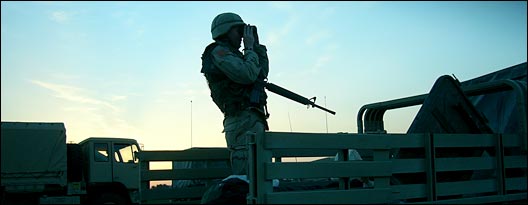Dear Umbra,
My husband just spread some very toxic weed-killer on our lawn, and I told him there must be a safer way to get rid of weeds. Our children and pets were not allowed on the lawn for 24 hours. We have a well and septic system, and I was wondering if that stuff would seep into our water supply. I also worried about the birds and other wildlife that visit our yard. Thanks for any help you can offer.
Doreen
York, Maine
Dearest Doreen,
I can’t tell you too much about the effects of the spraying without knowing the specific herbicide. So, of course, I’m going to give you the resources to figure it out on your own. But first, let’s talk about getting rid of weeds.

Is it safe?
Photo: iStockphoto.
The obvious primary problem is deciding that certain plants are weeds in the first place. A grass lawn is actually an unhealthy monocrop. Other plants present in the lawn provide visual diversity, nutrient cycling, pest diversions, etc. In addition, wide and frequent application of pesticides of any sort (herbicides are a subcategory) without regard to the life cycle or ecological setting of the target plant is a waste of money and creates more problems than it solves.
Unfortunately, this argument doesn’t get far with most people, who are hypnotized by lawn-company pabulum. One example of a prevalent home herbicide is 2,4-D, a component of popular “weed and feed” products. It kills broadleaf plants, so of course it is in the interest of the producing companies to discourage broadleaf plants as part of a proper “lawn”; they wouldn’t be able to sell their product otherwise.
If you do wish to rid yourself of certain plants, you must stop them from spreading by pulling them out. I’ve written about this before, and I have a great example of it in two friends who love their lawn, mow it weekly, and for two years have hand-pulled every non-grass plant. Their all-grass lawn looks great, I gotta say, and they get lots of fresh air and exercise.
Nothing I’ve said will make any dent on a serious lawn-lover. Time to turn to the pesticide resources. There are many, so once you start looking you’ll be able to spend hours reading. For an introduction to the contents of pesticides, try Beyond Pesticides; you’ll be able to get fact sheets about specific ‘cides there as well. The Pesticide Action Network is a similar resource, with a database instead of fact sheets. The EPA maintains a pesticide page, if your husband would find government data more persuasive.
Once again I am going to plug cooperative extension, the agriculture and forestry outreach programs funded by our very own government. Most extensions have a horticulture program with information for homeowners on reducing horticultural pests (this includes weeds), and sure enough, your own Maine Cooperative Extension has a section about this very topic. Your local land-grant university, a great resource for every American.
‘Tis of Theely,
Umbra


